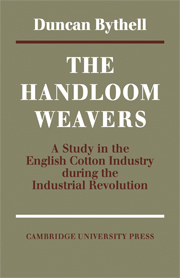Book contents
- Frontmatter
- Contents
- Preface
- Introduction
- Map of the weaving towns and villages of north-east Lancashire in 1821
- 1 Problems and sources
- 2 The organization of the industry
- 3 The labour force
- 4 The coming of the powerloom
- 5 Wages: (I) The piece-rate
- 6 Wages: (II) Earnings and the standard of living
- 7 Public opinion and the handloom weavers
- 8 Organized industrial action among the cotton handloom weavers
- 9 The weavers and radical politics
- 10 The problem of poverty
- 11 Displacement and disappearance
- Appendix 1 Some piece-rate series
- Appendix 2 The piece-rate and the price of food
- Appendix 3 G. H. Wood's estimates of average weekly earnings
- Bibliography
- Index
4 - The coming of the powerloom
Published online by Cambridge University Press: 07 October 2011
- Frontmatter
- Contents
- Preface
- Introduction
- Map of the weaving towns and villages of north-east Lancashire in 1821
- 1 Problems and sources
- 2 The organization of the industry
- 3 The labour force
- 4 The coming of the powerloom
- 5 Wages: (I) The piece-rate
- 6 Wages: (II) Earnings and the standard of living
- 7 Public opinion and the handloom weavers
- 8 Organized industrial action among the cotton handloom weavers
- 9 The weavers and radical politics
- 10 The problem of poverty
- 11 Displacement and disappearance
- Appendix 1 Some piece-rate series
- Appendix 2 The piece-rate and the price of food
- Appendix 3 G. H. Wood's estimates of average weekly earnings
- Bibliography
- Index
Summary
The unimproved handloom was one of the most ancient and simple of man's inventions. The materials used in its construction were easily obtained, and the mechanical principles on which it worked were primitive. In the mid-eighteenth century, all the cloth produced in England, with the exception of certain articles in the small-ware trade, was woven on a wooden loom consisting of four uprights joined together by crosspieces at top and bottom to form the framework of a box. A wooden roller or beam was placed between the pair of uprights at either end of the frame. The warp thread was let off from the first of these beams, and the newly woven cloth was taken up on to the second.
The basic operation of weaving consists in sending the shuttle which contains the weft thread from one side of the loom to the other through the threads of the warp, and in driving the weft threads closely together to form even cloth. To achieve this, two devices were added to the simple superstructure of the loom. The first of these, the healds, were operated by means of foot-treadles which raised and lowered the alternate warp threads between each passage of the shuttle and created the ‘shed’ through which the shuttle moved. The second was the lathe, which hung pendulum-like from the top of the loom above the cloth beam.
- Type
- Chapter
- Information
- The Handloom Weavers , pp. 66 - 93Publisher: Cambridge University PressPrint publication year: 1969
- 1
- Cited by



